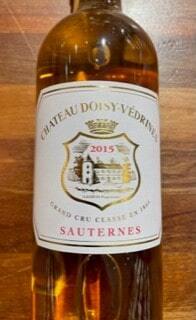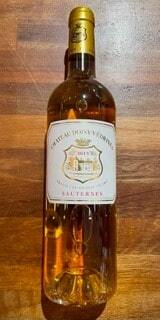Chateau Doisy Vedrines 2015
Originally, this castle was part of the mighty Doisy estate, but in 1851 it was split into three parts: Doisy-Vedrines, Doisy Däene and Doisy Dubroca. The former is with its 30 ha the largest of the properties and is today owned by the Casteja family, who already make a name for themselves with well-run castles in both Pomerol, Saint-Emilion and Médoc. Although the castle is located in Barsac, the manufacturer has chosen to use only the permitted Sauternes appellation. Doisy-Vedrine is classified as 2nd cru, but in good vintages, the wines from here reach the top level. The property has 27 ha cultivated with an average of 30 years old vines. The grapes are 80 percent. semillon, 15 pct. sauvignon blanc and the rest muscadelle, which are harvested manually in several rounds - and only when they have been attacked by botrytis (noble rot). Vinification takes place in a combination of oak barrels and steel tanks, and subsequently the wine is stored for 18 months in barriques, of which 60 per cent. are new. This gives an intense, clean and refined dessert wine with notes of honey-sweet fruit, white chocolate and roasted almonds, and in this vintage from 2013, the flavor nuances have really had time to settle down, so they dress each other and have calmed down completely.
Originally, this castle was part of the mighty Doisy estate, but in 1851 it was split into three parts: Doisy-Vedrines, Doisy Däene and Doisy Dubroca. The former is with its 30 ha the largest of the properties and is today owned by the Casteja family, who already make a name for themselves with well-run castles in both Pomerol, Saint-Emilion and Médoc. Although the castle is located in Barsac, the manufacturer has chosen to use only the permitted Sauternes appellation. Doisy-Vedrine is classified as 2nd cru, but in good vintages, the wines from here reach the top level. The property has 27 ha cultivated with an average of 30 years old vines. The grapes are 80 percent. semillon, 15 pct. sauvignon blanc and the rest muscadelle, which are harvested manually in several rounds - and only when they have been attacked by botrytis (noble rot). Vinification takes place in a combination of oak barrels and steel tanks, and subsequently the wine is stored for 18 months in barriques, of which 60 per cent. are new. This gives an intense, clean and refined dessert wine with notes of honey-sweet fruit, white chocolate and roasted almonds, and in this vintage from 2013, the flavor nuances have really had time to settle down, so they dress each other and have calmed down completely.
There is no reviews yet. Be the first to write us your opinion






